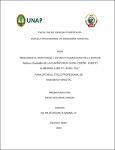Crecimiento, mortandad y estado fitosanitario de la especie Dipteryx charapilla de la plantación N° 36 del CIEFOR - Puerto Almendra, Loreto - Perú. 2021
Abstract
The study was carried out in Forest Parcel No. 36 of 1 ha in CIEFOR - Puerto Almendras, evaluating 200 Dipteryx charapilla plants, planted every 5 meters and in 10 strips. The greatest increase in diameter was presented by band 8 with a value of 0,06 mm between the first and last evaluation. Likewise, in height the greatest increase was presented by band 7 with a value of 5,61 cm. The Chi-square test indicates that there is a significant difference between the averages of increase in diameter - height and the bands (p-value = 0,00 <? = 0,05). The survival of cedar plants varies between 75% to 100% survival, while mortality varies between 10% to 25%. The highest number of plants presented GOOD quality with 129 seedlings that represents 71,27% of the total, followed by REGULAR quality with 35 live individuals that indicates 19,34% and, finally, the least amount of individuals were observed in BAD quality with 17 seedlings that represented 9,39 % of the total. At a general level in the experiment Good quality was recorded for the Dipteryx charapilla seedlings at the end of the study. Similar studies are needed with other native forest species in CIEFOR - Puerto Almendras. El estudio se realizó en la Parcela forestal Nº 36 de 1 ha en el CIEFOR – Puerto Almendras, evaluándose 200 plantas de Dipteryx charapilla, sembradas cada 5 metros y en 10 fajas. El mayor incremento en diámetro lo presentó la faja 8 con un valor de 0,06 cm entre la primera y última evaluación. Asimismo, en altura el mayor incremento lo presentó la faja 7 con un valor de 5,61 cm. La prueba de Chi-cuadrado indica que existe diferencia significativa entre los promedios de incremento en diámetro – altura y las fajas (p-valor= 0,00 < ?= 0,05). La sobrevivencia de las plantas varía entre 75% a 100% de sobrevivencia, mientras que la mortalidad varió entre 10% a 25%. El mayor número de plantas presentaron calidad BUENO con 129 plántulas que representa el 71,27% del total de plántulas evaluadas, seguido por la calidad REGULAR con 35 individuos vivos que indica 19,34% y, finalmente la menor cantidad de individuos se observaron en la calidad MALO con 17 plántulas que representó el 9,39% del total. A nivel general en el experimento se registró la calidad Bueno para las plántulas de Dipteryx charapilla al final del estudio. Es necesario realizar estudios similares con otras especies forestales nativas en el CIEFOR - Puerto Almendras.
Collections
- Tesis [527]


